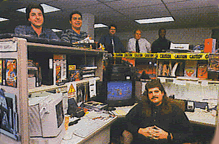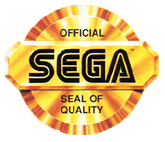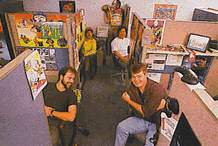Working at Sega during the ’80s and ’90s was a fan’s dream come true. The company was in its prime, and there was a ton of incredible software making the rounds throughout the building at all hours of the day (and into the wee hours of the night, too!). I’m sure that many of us would have  squealed with glee just to land a job in the mail room, but what if you could actually get paid to play Genesis games before they were released? Even better, what if you got to play games made by other companies? I bet that caught your interest!
squealed with glee just to land a job in the mail room, but what if you could actually get paid to play Genesis games before they were released? Even better, what if you got to play games made by other companies? I bet that caught your interest!
Sega-16 has spoken to Sega in-house testers before, but this time we got the chance to chat with one who tested third party titles. Tom Byrne had a dream job for several years at Sega, and along the way he rubbed elbows with some of the brains behind the magic and even played a few games that never made it to store shelves. We cornered Mr. Byrne and refused to let him go until he answered all our questions. As you can see below, he’s safe and sound now!
Sega-16: How did you get your start at Sega? Was it through a standard application for a testing position or did you start in another position?
Tom Byrne: In the fall of 92 I was out of work , so I would read the Sunday classified ads in the San Francisco Chronicle. I would look at the computer section just out of curiosity, I had no programming experience besides basic, but I did know EA’s Deluxe Paint, and sometimes they would look for people who used that program. So looking at the fine print, I can’t remember if it read Genesis or Sega, but I made a call, and got an interview with a temp/contractor. They said they needed game testers, but they didn’t mention the company. A couple days later,I found out it was at Sega, and I would work as a temporary employee through the contractor, The first couple of weeks, I worked in product development testing their in-house games.
I came in at the height of the holiday rush. It was a nut-house, a very eclectic group of testers, and they were grabbing college students, geeks, MIT grads, moonlighters… I worked with these two Desert Storm ex-marines who were about to graduate the police academy. Mostly cool people some shady types. One guy who I thought was shady, got murdered at a fast food parking lot. This was late ’92, Sega was growing fast! Every day the office building would find more space for game testers. We were testing Sonic 2, Little Mermaid, Ecco the Dolphin, and some other Disney games. We were pulling insane hours, I would do 55-65 hour weeks and that would kick my ass, and some testers were pushing eighty hours, getting great overtime. By November the test rush was winding down and out of the blue the contractor service called us and said “your services are no longer needed at Sega.” I thought my time at Sega was over, but a couple of weeks later, I got a call from third party for a test position! I felt reborn!
Sega-16: Give us the rundown of a typical day at work.
Tom Byrne: When I was there, we were in a modern two story building in Redwood Shores right off 101, about two blocks from the glass Oracle offices. I’d get in at 8:45 to 9:00 am and start drinking coffee right off. We’d have to keep the games locked-up – losing a pre-released game is a big no-no! We could always burn more, but there’s just the suspicion of leaking a game, yikes! If you’ve seen the EPROM cartridges before, they’re like a long circuit board you stick in the Genesis slot.
So, by 9:30 I would just start playing. We had our own cubicles for the first year and a half, and Sega was renting out office space faster than they could fill it, but eventually it filled-up. I would play until 10:00 a.m., then us smokers would have a ritual “morning cig.” It was cool because you’d be smoking with upper management, and major higher-ups from Japan. In the smoking section, you’re all equal!
*Back to testing*. I would usually test platform games, puzzles or RPGs. My niche was turn based strategies from KOEI. I would test until lunch.
*Lunchtime:* We would usually drive to someplace along the El Camino for lunch Pizza, Chinese, or burritos. Sometime I would have two lunches. We were right next to Marketing, and they’d always have catered meetings with the advertising bigwigs from San Francisco. We’d then eat the leftover catered food which was usually really good pesto tortellini, bread, cookies, and drinks.
*1:15 pm back to testing*- We would swap games with other testers for varying opinions, and the other testers would try it for around thirty minutes just to get a general impression. The report I would submit to the account exec would detail all the discrepancies, if any, and the opinions of three other testers. I don’t know if the A,B,C testing standard is still in use, but here’s what we were looking out for: “A” bugs were fatal crashes nastiest of the nasty, “B” bugs were significant discrepancies that didn’t crash the game, but affected gameplay, “C” bugs were general annoyances that we could suggest changing. Most of the day was just playing the game, we were supposed to finish the game and submit a report within a week.
The rest of the afternoon was just playing the game. We were a pretty tight crew, so there was a lot of laughs going on – we could test and joke simultaneously. Marketing loved us because we were always blurting out really bizarre funny stuff. We were the Testers!
Sega-16: It’s interesting that Sega had a hand in testing third party software. Was this something publishers did voluntarily, or was it mandated by Sega itself?
Tom Byrne: Third party test was mandated by Sega to ensure quality. They didn’t want to make the mistake Atari did of having absolute crap being sold on their system (see ET for the Atari 2600!). We would accept the game from a third party assuming they’d have it completely tested, but there would still be bugs! We were looking for crash bugs, playability bugs, decency issues (like overt violence and nudity) and legal/copyright disclaimers.
Sega-16: How receptive were third parties to your results? Did the fact that you worked for Sega and not them ever factor in their input?
 Tom Byrne: Most companies were very polite and responsive, since they always wanted to be on good terms with Sega. With most of the bugs they were like, “yeah we should have found that” and/or “oops sorry.” It’s very frustrating for a third party publisher because this is the last hurdle before replication and packaging. Most of the back-and-forth would be done through the account execs, I would rarely speak with the third party publishers. They would just read our write-ups. They didn’t want us unruly game testers communicating with clients.
Tom Byrne: Most companies were very polite and responsive, since they always wanted to be on good terms with Sega. With most of the bugs they were like, “yeah we should have found that” and/or “oops sorry.” It’s very frustrating for a third party publisher because this is the last hurdle before replication and packaging. Most of the back-and-forth would be done through the account execs, I would rarely speak with the third party publishers. They would just read our write-ups. They didn’t want us unruly game testers communicating with clients.
There was the Heimdall fiasco, this was too funny! There were statues all over the game with these, (are kids going to read this?) I’ll call them extreme phallic extensions, quite obvious. So I wrote it up as an “A” bug and some poor guy had to replace them. The next submission, I don’t know if it was passive aggression or oversight, but they left one well endowed statue in the final room of the last level. I think some European designer was thumbing our American puritanical hypocrisy, I don’t know, anyway it was gone by the third and final submission.
Sega-16: Did Sega itself ever influence the quality of another company’s game, or were third parties given their own space for quality control?
Tom Byrne: By the time a game is was submitted for third party test, the developers believed, at least in their heart, it was a finished product. We could only suggest changes, and smaller developers were more responsive. Most of the changes we suggested were last minute touch ups, unless it was something that must be changed before approval. We didn’t have the power to make bad games good. These were the days when companies like Acclaim were churning out movie or super-hero licensed platform games. The games looked OK, the control was good, but it was the same old game with different costumes. If the game was super duper good, and if the publisher didn’t have the marketing muscle, Sega would negotiate to buy the product and polish it up in-house.
Sega-16: Of all the titles you tested, which games most stand out to you?
Tom Byrne: Oh boy, Well since I was a big turn-based game fan, I really liked the Nobunaga games by Koei. The other testers wondered, “Why does he like those boring games?”
Sega-16: Did you meet any famous Sega personalities during your time?
Tom Byrne: Hmmm, famous….. famous? You mean famous for their achievements at Sega? I’d need some examples. because I’m trying to think of anyone who would fit that description. I don’t remember walking down the halls and seeing people of video game notoriety, I might have by chance, but I probably didn’t pay attention. Our section wasn’t like a publisher, or developer, with a bunch of creative types running the place; it was pretty corporate. We had marketing, legal, and human resources etc. I think the “star developer” was an new idea at the time. Personally, I was never one to cling to the celebrity notion when it comes to video games, I did see Dave Perry at CES, A level designer friend pointed him out to me, He was going back-and-forth on whether to talk to him or not.
Sega-16: How about unreleased titles? Were you involved in any?
Tom Byrne: Oh yeah, my first thought would be Blood Bowl. It was one of those weird submissions they just wanted to see if it was worth pursuing. It was a flat football field with players running like Egyptians. It was like side-view Speedball 2, but you tear the heads off of enemy opponents and run with them. In a way I liked it, but it was too raw for the Genesis. There were a lot of Japanese games that never made it to the stateside. The content was just too way out, over the top sex and violence. Back then a company would make a game for the PC or Amiga. When the Genesis became popular, the publisher would make a port for the new system., I guess it was a worthy risk if it sold on other systems.
 Sega-16: How long were you at Sega?
Sega-16: How long were you at Sega?
Tom Byrne: I worked from November of 1992 until April of 1994, I then got job at a developer as an artist. The first game we worked on went through Sega third party submissions. It passed.
Sega-16: Many of those who have aspired to enter the video game industry have seen testing as a way to get a foot in the door. Do you think this still holds true?
Tom Byrne: It could be one avenue. You’ll learn how the business works, and you can make some great connections. I think the best way to get a job is learning programming, 3D modeling, and level editors like UnrealEed. Look at all the free tools available, Internet access, etc – in the early nineties there was none of that. Back then I wanted in, I wanted access to the tools! Now it’s pretty much a download away! Look at the guy who created Counter Strike… with a little inspiration and motivation anyone can create a top-selling game. It has to be good, but that’s up to you!! If you get a testing gig, always make a good impression, make an effort to be sociable, punctual, and try to have at least, average writing skills. Higher-ups will read your reports, so what you write and how you write can determine your career’s future. If one was to pursue a producer gig, it might help to go up the chain from test. I guess testing wouldn’t hurt if you wanted to work in development. So, in summary, it wouldn’t hurt to have a test background.
We would like to thank Mr. Byrne for taking the time for this interview.

Recent Comments